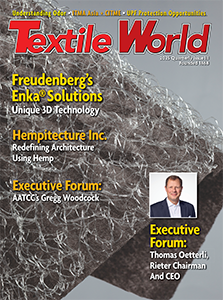WASHINGTON — January 11, 2016 — The American Apparel & Footwear Association Board of Directors today announced that Rick Helfenbein, an experienced apparel and footwear executive and current AAFA Chairman, will take on the role of president and CEO starting February 15.
“It is a great honor for me to have been selected to lead AAFA,” said Helfenbein. “Having worked in the industry my entire career, I understand the important issues that we face and will continue the fight to expand and protect opportunities for all our member companies.”
Helfenbein served as AAFA Chairman for the last two years and has served on the AAFA board since 2008.
During his time on the AAFA board, he has spent countless hours on Capitol Hill helping to secure several legislative victories including the passage of the Generalized System of Preference Update legislation, the first significant change to the GSP program in 40 years.
“When the opportunity came to select a new CEO for AAFA, we wanted a seamless transition and chose someone who could build on the momentum we’ve created,” said Rob DeMartini, incoming chairman of AAFA. “Rick’s leadership, passion, and dedication to AAFA is clear, and that made his appointment an easy and strong choice.”
For the past 16 years, Helfenbein has directed the USA operations for Hong Kong-based apparel and footwear giant, Luen Thai (HK 311), and was one of the key executives that helped grow the company into the largest publicly listed apparel, accessory, and footwear manufacturer on the Hong Kong Exchange. Prior to Luen Thai, he has had extensive experience in USA apparel manufacturing, USA Textile Mills, and Central American sourcing.
Helfenbein has been active in all of AAFA’s key events, including AAFA’s annual Executive Summit in Washington, D.C. and the American Image Awards, the industry’s fashion, policy, and business gala in New York City. He has also been active in promoting AAFA’s global presence, appearing several times on national television with commentary about international trade and other industry related issues.
“As a board member, former chairman, and active member of AAFA, I know the caliber of the work at AAFA,” Helfenbein said. “I look forward to working closely with the AAFA team to enhance our leadership position on trade issues, protect our members’ intellectual property, and to be the number one trade organization for our industry, where members can discuss and act on our most important issues.”
Helfenbein will take on role of CEO, currently held by Juanita Duggan who announced her resignation in November. Duggan is leaving to take on a new role and remains CEO until February 8.
Helfenbein holds a Bachelor of Science degree in economics from The Wharton School and participates annually in the Consortium for Operational Excellence in Retailing (COER) at Wharton and Harvard. He lectures frequently on the subjects of supply chain and international trade at industry events, and prestigious business schools including Wharton, Harvard, Cornell, and Columbia.
Posted January 12, 2016
Source: AAFA




